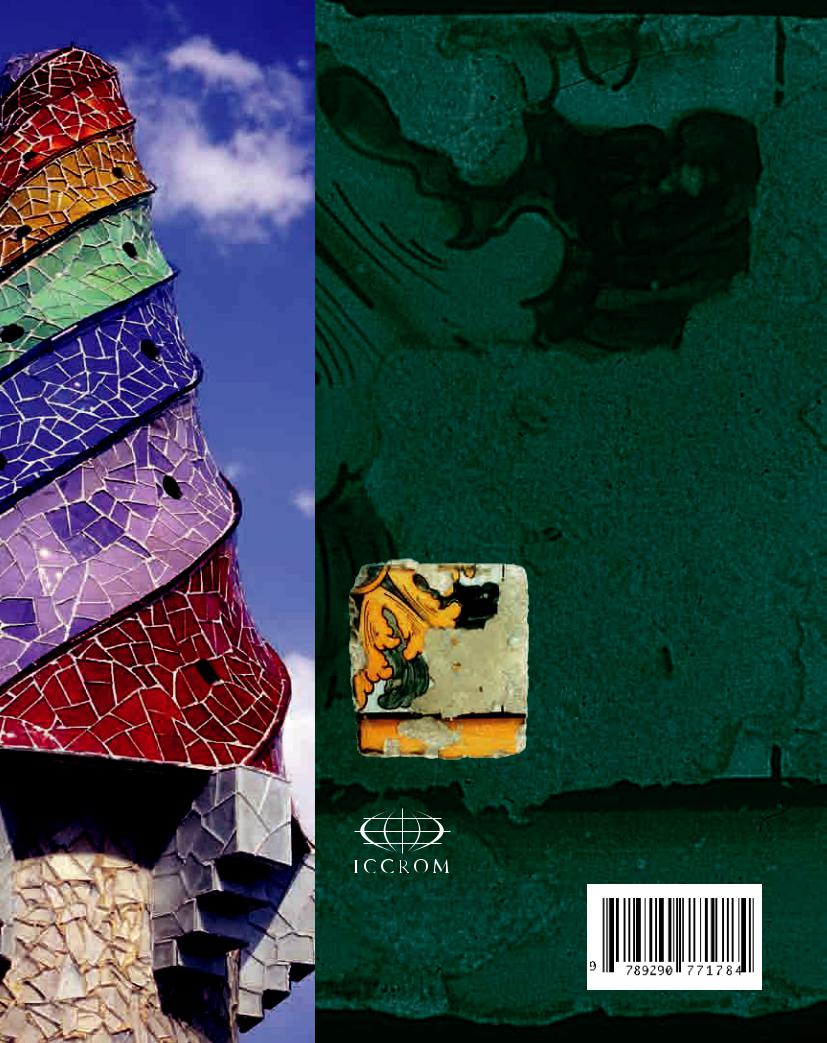
ICCROM_ICS01_CeramicaDecorada00_es
.pdf
Conservation and restoration of glazed architectural ceramics in northern Germany
Hans-Jürgen Schwarz, Sabine Freyburg,
Peter Mottner, Erwin Stadlbauer
Glazed architectural ceramics have been used for building decoration since late mediaeval times, especially in the northern part of Germany. The commonly used lead-silica based glazings are damaged by weathering processes as well as by soluble salt action. The deterioration processes of the glazings are similar to those known from glass corrosion, but there are also phenomena that depend on the properties of the contact zone between the slip and the ceramic body underneath. A research project began early in 2001 to investigate the damage mechanism and find out the best fit methods and materials for the consolidation and restoration of damaged glazed architectural ceramics and terracotta.
[page 38]
Restoration of glazed ceramics in Plaza de España
José Antonio Solís Burgos
The restoration currently being carried out on the glazed ceramics in Plaza de España in Seville focuses on two groups of elements: the 'bancos de provincias' seats, and the bridges over the river.
The work consists of replacing unrecoverable pieces of the bridges, and cold or hot restoration of the backs of the “bancos de provincias” seats.
This is being carried out by the Escuela Taller 'Plaza de España' acting under the advice of the Technical Commission which comprises ceramics experts, restorers, architects, historians and a technical architect.
One particularly interesting feature is the research into a new paste which will make it possible to restore the original volume thanks to a total lack of shrinkage. The use of sodium silicate as the adhesive, and the application of the new paste made with calcium carbonate, kaolin and 'chamota' is opening up new avenues of study in the field of restoration, particularly for pieces that are exposed to the weather.
Because of the magnitude of the problem, with more than 500,000 pieces of glazed ceramics in the Plaza, the search for new solutions is essential if it is to survive into the future.
[page 42]
Abstracts 157

General criteria for restoration of glazed ceramics in architecture
Pilar Giráldez
This paper examines the possibility of providing general conservation and restoration criteria for glazed ceramic materials applied to architecture in order to work out a general working method.
The steps to be taken should be: The purpose of the operation and the use of the building when the work is completed should be decided. A comprehensive and accurate diagnosis as a means of subsequently identifying the problems and the methods for dealing with them should be carried out. A comprehensive plan for the operation should be drown up using uniform criteria for the whole building. Appraising operations carried out previously and giving priority to conserving original materials is important. Priority should be given to recovering the structural support rather than the aesthetic aspect. A photographic and graphic recording should be made that can be stored and consulted. Chemical tests should be carried out to check the deterioration and ceramic materials should be stored. Traditional techniques should be used to replace parts. The thickness of the pieces should vary in order to be able to identify the new ceramics. Synthetic resins should not be used out of doors. Temporary restoration criteria should be avoided. The recomposition of the ceramic should be a means of helping to recover space. It is necessary to avoid decontextualisation by removing panels and putting them in museums. A plan should be drawn up for the conservation and maintenance of the site after the operation. A catalogue of ceramic elements in their own context, and ceramic elements out of context should be published.
[page 48]
Glazing: between architecture and conservation
Paolo Fancelli
Through specific, practical examples the text succinctly examines the question of the relationship between glazed ceramics and architecture and how the two physically come to be realized as one.
From a technical point of view, the concept of the process of glazing illustrates an analogous fusing of two diverse materials, that of ceramic and glass. The principle causes and types of degradation that can occur in glazed coatings is addressed. Within this context the complex issue of losses must by constantly confronted. The most important degradation issues relating to loss are analyzed from theoretical, art historical, and practical conservation perspectives. In conclusion, an outline of potential ways to address these issues are presented following the basic formulations of first, a theoretical conservation and secondly, a “mental” reconstruction, in which the analysis of glazed ceramics plays a fundamental role in the conservation, restoration, and museum installation of architectural elements.
[page 52]
158 El Estudio y la Conservación de la Cerámica Decorada en Arquitectura

Tradition, modernity, synthesis:
glazed ceramics in architecture and Gaudí
Antoni González Moreno-Navarro
The restoration of the Palau Güell is understood as the recovery of its authenticity, which had been lost or damaged by the perishability of the materials or their incorrect use - an authenticity which is not related to the originality of the matter, but to its capacity for expressing genuine aspects (space, shape, texture, colour) of Gaudí’s work. The means employed are chosen with “eclecticism and elasticity”: in some cases the mimetic reconstruction of lost or damaged elements has been decided upon; in others, the analogous recovery based on the concept of harmonious diachrony.
The work on the flat roof aimed at facilitating its public use and highlighting the singular elements without losing their character, which was to be a mixture of domestic service terrace and of open-air museum of sculptures. This diversity of objectives and circumstances made this the place where this diversity of attitudes was most manifested, especially in the restoration of the twenty chimneys which surround the central needle crowned by the suggestive lightning conductor-weather vane.
[page 58]
Glazed ceramics in Córdoba, Argentina
Freddy Guidi, Valeria Druetta,
Patricia Camusso, Melina Malandrino
This paper reviews the use of this material in the Argentine Republic, and particularly in the cities of Córdoba and San Francisco in the 17th, 19th and 20th centuries. The study was based on a bibliographic survey and technical files with photographs of the following examples: the churches of Santo Domingo, Merced and Pilar (Córdoba); the Colegio Nacional de Monserrat (Córdoba); Palacio Tampieri and Casa Martínez (San Francisco); and Plaza San Martín (San Francisco).
Glazed ceramics were widely used in Argentina throughout the 19th and early 20th centuries. This ornamental resource was imported from Europe to Rio de la Plata and from there it spread into the interior. The study of its use enables us to interpret changes in taste, the prevailing ideology and the commercial and cultural policies of the newly-established republic, as well as the transculturation process that was taking place at that time. The main groups of glazed ceramics that appeared one after the other are: French stanniferous tiles, English tiles, and Belgian tiles based on art noveau, and Spanish ceramics.
[page 64]
Abstracts 159

Conservation of tiles in the Convent of San Francisco de Lima:
World Cultural Heritage.
César Matta Puga
Restoration is a product of the social and cultural evolution of each people. This makes it essential to understand changes in the uses of monuments, and the needs of monuments, in order to avoid the problem of turning them into museums.
The Convent of San Francisco de Lima with its abundance of decorative tiles of Spanish origin may be considered to be the most representative monumental complex in the historical centre of Lima.
The problem with the tiles is the fact that a panel of tiles measuring 3 x 9 metres in the northern corridor of the cloister was detached by the effects of a bomb explosion in 1991.
The paper explains the work that was undertaken before embarking on restoration proper: topographic survey, cleaning and securing.
A number of restoration and conservation solutions on the tile panel in situ are listed:
•The replacement of the panel in its original vertical position with the aid of hydraulic clamps,
•The removal of the whole or part of the panel,
•The dismantling, consolidation and restoration of parts of it,
•The consolidation of the panel in the position where it stands.
Lastly, it explains the need for a debate and for ongoing studies on the theory and practical
methods of conservation and restoration in each social context.
[page 71]
Criteria and intervention in tile surfaces: the case of Iran
Mehr Azar Soheil
Because of the outstanding significance of glazed-tile facing in Iranian traditional architecture, there has been much attention to the repair and continuity of this form of artwork. Although the normal practice has been to reintegrate the damaged or missing parts with new tiles, efforts have been made to recover and reuse the original material as much as possible, especially in the case of intarsia tile technique. The practical and aesthetic aspects of interventions in relation to functional necessities are considered here with attention to the concepts of the modern approach to conservation. The most problematic issues regard the use of appropriate materials, the method of reintegration of lacunae, and the quality and durability of treatments. Some general issues are also mentioned; these are common to most developing countries and include the lack of master craftsmen and economic restrictions.
[page 79]
160 El Estudio y la Conservación de la Cerámica Decorada en Arquitectura

On the training of the restorer/conservator of architectural glazed ceramics
Giovanna Bandini
In this paper, existing restoration courses which include ceramics as an area of study are examined in order to identify the essential features of a specialised training course for restorers/conservators of glazed ceramic works applied to architectural contexts. Particular features, as well as the values and limitations, of these courses, are examined through the eyes of a teacher looking at the practical uses of these courses.
Requisite professional qualities identified are: the ability to make a technological ‘reading’ of the artefacts; a knowledge of the fundamentals relating to the history of art, architecture and restoration, with constant and specific reference to ceramics; a knowledge of the theoretical/ethical principles governing restoration; an appropriate training in conservation and restoration methods and procedures to be implemented on glazed items forming part of architectural contexts; and a sound ability to plan and manage a restoration site. In short, a professional who is a cultural all-rounder, able to organise and implement restoration programmes, however complex, on architectural glazed ceramics including those that are applied to monumental environments.
[page 88]
Reflecting on conservation of ceramics on architecture
Jaume Coll Conesa
The conservation of ceramics applied to architecture is a difficult issue to address because of the problems raised by the material itself, to which architecture poses serious challenges that are difficult to resolve. Nevertheless, the documentary value of the unity of a monument requires a comprehensive treatment in which the preservation of all the parts that comprise the monument are treated under the same conditions. Architectural conservation, as in other areas of restoration, must be a multi-disciplinary process in order to guarantee that the multi-faceted aspects of the whole are taken fully into account, and that the solutions are decided rigorously. Four principles are proposed in this paper to govern the conservation of ceramics applied to architecture: the principles of the unity of the context, safeguarding a moveable item, authenticity, and maintenance.
[page 95]
Abstracts 161

Training on conservation and restoration of azulejos: the Museu nacional do Azulejo in Lisbon
Paulo Henriques
In Europe, and arguably in the rest of the world as well, Portugal holds a pre-eminent position for its use of ceramics as architectural covering, particularly in the form of glazed tiles. Since the 16th century, the tile has been continuously put to many different uses and given prominence in a uniquely original manner, creating a tradition of total indoor and outdoor tile covering on a monumental scale, both for aesthetic taste in itself and as a vehicle for disseminating ideas through the images depicted on the tiles on buildings and in cities.
This article sets out to explain the continuity and extent of what is not merely a decorative tradition. The widespread use of ceramics and the practice of monumental ceramic covering have given Portugal a huge, diversified heritage which pose complex preservation problems. Since 1980, the joint efforts of conservation and restoration specialists, art historians, structural engineers, materials technologists and other professionals have enabled the Museu Nacional do Azulejo in Lisbon to establish the conservation and restoration of this major component of our artistic heritage as a professional, as well as an exceptional, specialism.
[page 99]
Thinking about training professionals on restoration to face the problem of preserving faience work “azulejaria”
Mário Mendonça de Oliveira
This paper points out the importance of restoring Brazilian tiling. Tiles have been widely used in this country as mural coating. The material has a high aesthetic and historical value, and some complexity in its elaboration. In addition to requiring a critical and aesthetic training, there is also a need to emphasise the importance of thorough scientific and technological training for restorers, not only those who are responsible for conserving tiled surfaces, but also in general terms, involving all conservation and restoration operations. Finally, some theoretical and critical points are discussed and the apparent conflict that exists with the need to guarantee the longevity of the tile heritage.
[page 103]
162 El Estudio y la Conservación de la Cerámica Decorada en Arquitectura

Formative training in the field of conservation and restoration of architectural ceramics
Paolo Saturno
Ceramic elements used in architecture should be recognized as significant forms of artistic expression that reflect the creativity and aesthetic taste of an entire community. Issues regarding the conservation and restoration of such materials must be confronted to ensure a holistic preservation of the physical “container” along with the historic and artistic value it carries. In order to meet these demands, the redefinition of a theoretical and practical approach to architectural ceramic conservation training is proposed, in which aspects of ceramic technology (ancient and modern), preventive conservation, and restoration techniques are integrated with an awareness of the singular ceramic element as part of a broader architectural context. Fundamental to this new approach is the international collaboration between the conservation profession and all sectors traditionally involved with polychrome ceramics. The interaction between the ceramic artifacts and the surrounding environment that is responsible for its degradation should be investigated and ultimately diminished through the establishment of controlled maintenance.
[page 109]
ICCROM and documentation
Marie Christine Uginet
The topic of the conservation of architectural ceramics serves as an example from which a general lack in documentary research and publication by the conservation profession is noted. The conservation world has a responsibility to publish scientific documents regarding research results and conservation work in order to promote the diffusion of information for the benefit of future documentary research. This stance coincides directly with one of ICCROM’s founding principles: to assemble, study, and diffuse information concerning scientific questions, techniques, and ethics having relevance to the conservation and restoration of cultural heritage. A testimony to ICCROM’s success in adhering to this aim is its establishment of one of the most expansive, international libraries in the world for the conservation of cultural heritage. The library facilitates and promotes research on an international level through its consolidation of information from wide-reaching sources and its availability to researchers from every corner of the world via its catalogue accessible on the Internet.
[page 116]
Abstracts 163

“European ceramic tiles circle – Information Bulletin”
Frans Caignie
The Dutch Tile Museum’s extensive collection of wall tiles and tile panels presents information to the public about the technology and historical development of this ceramic material. The collection and activities of the museum are supported by the Foundation, Friends of the Dutch Tile Museum, which coordinates an array of related events such as meetings, lectures, exhibitions, and the publication of newsletters and scientific journals. In 1995 the Foundation broadened its scope through the creation of the European Ceramic Tiles Circle (ECTC), whose primary activity is the publication of the biannual Information Bulletin. The Bulletin functions as a forum for the exchange of information between museums and other organizations involved with the study of European ceramic tiles. All members are invited to contribute to the publication by providing information about tile related events (exhibits, publications, private collections, public auctions) in order to increase its value as a resource for the entire European tile community.
[page 118]
The DGEMN and the heritage inventory “Azulejo”
Ana Paula Rebelo Correia
As part of its responsibility for safeguarding and preserving the Portuguese-built heritage, the Direcção-Geral dos Edifícios e Monumentos Nacionais (DGEMN) set up the Thematic Inventories project in 2001 focusing on "architectural components" such as stucco, mural painting, gilt carved wood and azulejo (tile), all of which are often threatened by theft, destruction or adulteration. To address its five centuries-old tile heritage, DGEMN started by inventorying the buildings that were already registered in the IPA (Architectural Heritage Inventory). The work centred around figurative tiles from residential civil architecture in the district of Lisbon from between the 16th and the 18th centuries. The inventory includes a description of each panel, its location within the building, the number of tiles, colour, iconography, chronology and state of conservation. The inventory records, which include images and graphic data, are available on the Internet. This AZULEJO inventory has two basic objectives: inventorying to preserve the heritage, and iconographic research. The latter includes research into widely-used graphic sources (painting, drawing or etching), partially or totally copied and adapted to the grand scale of architecture by restorers, architects and historians in general. Noteworthy in this area are the panels of Palácio Centeno based on etchings by António Tempesta, and the panels of Palácio Belmonte depicting episodes from the life of Aeneas, based on etchings by Carlo Césio.
[page 121]
164 El Estudio y la Conservación de la Cerámica Decorada en Arquitectura

published by iccrom
Via di San Michele, 13 I-00153 Rome, Italy iccrom@iccrom.org www.iccrom.org
